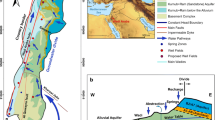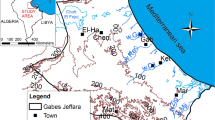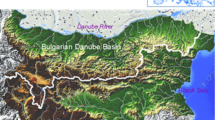Abstract
In this work, two methods were used to assess the groundwater natural recharge of the Sisseb El Alem Nadhour Saouaf basin (SANS) in Northeastern of Tunisia. In fact, the natural recharge of the SANS aquifer remains a major unknown for hydrogeologists and decision makers. Based on the various databases that include geology, sedimentology, hydrology, geochemical and isotopic data, the groundwater natural recharge was estimated using two different approaches. In a first approach, a historical measurement of tritium, the radioactive isotope, was used to calculate the age of modern groundwater (< 50 years). The application of the tritium radioactivity model shows that in the SANS basin the renewal rate of groundwater ranges between 1.3 and 3%. However, this is difficult to generalize across the entire aquifer, given the large spatial and temporal variations of rain, and the uncertainty affecting the measurement of tritium rates in rain, as well as the uncertainty of the used radioactivity model. In the second approach, a quasi-steady hydrological model called the WetSpass model (Water and Energy Transfer between Soil, Plants and Atmosphere under quasi-steady state) was used to assess the spatiotemporal variability of the recharge. The results show that the average annual recharge between 1971 and 2016 is 10 Mm3/year. A value that remains minimal and that characterizes this kind of arid region. The spatial distribution maps of the recharge show that the maximum recharge occurs in the northwest edges of the basin, west and in the southern part, at the level of the outcrop permeable formations of the aquifers. Finally, the two methods used show that the groundwater natural recharge is very heterogeneous and limited in time and space. However, these results remain a further step to ameliorate the water budget of the SANS basin to perform a realistic hydrogeological model.
















Similar content being viewed by others
References
Alazard M (2013) Etude des relations surface—souterrain du système aquifère d’ El Haouareb (Tunisie Centrale) sous contraintes climatiques et anthropiques. 378
Armanuos AM, Negm A, Yoshimura C, Valeriano OCS (2016) Application of WetSpass model to estimate groundwater recharge variability in the Nile Delta aquifer. Arab J Geosci. https://doi.org/10.1007/s12517-016-2580-x
Barreiras N, Ribeiro L (2019) Estimating groundwater recharge uncertainty for a carbonate aquifer in a semi-arid region using the Kessler’ s method. J Arid Environ. https://doi.org/10.1016/j.jaridenv.2019.04.005
Batelaan O, DeSmedt F (2001) WetSpass: a flexible, GIS based, distributed recharge methodology for regional groundwater modelling. Impact Hum Act Groundw Dyn 269:11–17. https://doi.org/10.1002/cncr.26610
Bedir M, Khomsi S, Houatmia F (2015) Basin dynamics and sedimentary infilling of miocene sandstone reservoir systems in eastern Tunisian African margin. European Geoscience Union General Assembly, 12-17 Apr 2015, Vienna
Bigot S (2002) Détection des discontinuités temporelles au sein des séries climatiques : point méthodologique et exemple d'application. Actes des Journées de Climatologie de la Commission « Climat et Société » du Comité National Français de Géographie, Strasbourg, pp 27–46
Boujamaoui M (2000) Stratigraphie séquentielle et sismique des faciès du Miocène de la Tunise nord-orientale. Compilation des données sismiques, diagraphiques et sédimentologiques. Thèse de Doctorat, Université de Tunis II, Faculté des Sciences Tunis, p 201
Castany G (1957) Sur l’âge récent de la phase ultime de diastrophisme majeur de l‘Atlas tunisien original. In: de Tunis AFAS (ed) IXXe Congres, vol. 1
Chae J, Kim G (2019) Seasonal and spatial variations of tritium in precipitation in Northeast Asia (Korea) over the last 20 years. J Hydrol 574:794–800. https://doi.org/10.1016/j.jhydrol.2019.04.058
Conti FL (2012) Using Satellite precipitation data to support local climatology and weather monitoring. Application to Sicilia. These de Doctorat. Universit`a degli Studi di Palermo
Edwards WRN, Warwick NWM (2011) Transpiration from a kiwifruit vine as estimated by the heat pulse technique and the Penman–Monteith equation. N Z J Agric Res. https://doi.org/10.1080/00288233.1984.10418016
El Mejri H, Ben Moussa A, Zouari K (2014) The use of hydrochemical and environmental isotopic tracers to understand the functioning of the aquifer system in the Bou Hafna and Haffouz regions, Central Tunisia. Quat Int 338:88–98. https://doi.org/10.1016/j.quaint.2014.04.046
Farid I, Trabelsi R, Zouari K et al (2013) Deciphering the interaction between quaternary and continental Sabkhas aquifers in Central Tunisia using hydrochemical and isotopic tools. Environ Earth Sci 70:3289–3309. https://doi.org/10.1007/s12665-013-2395-y
Farid I, Zouari K, Trabelsi R, Kallali AR (2014) Application des traceurs environnementaux à l’étude de la recharge des eaux souterraines dans une région semi-aride en Tunisie centrale. Hydrol Sci J 59:2072–2085. https://doi.org/10.1080/02626667.2013.863424
Gichamo TZ, Sazib NS, Tarboton DG, Dash P (2020) HydroDS: data services in support of physically based, distributed hydrological models. Environ Model Softw 125:104623. https://doi.org/10.1016/j.envsoft.2020.104623
Gleeson T, Befus KM, Jasechko S et al (2016) The global volume and distribution of modern groundwater. Nat Geosci 9:161–164. https://doi.org/10.1038/ngeo2590
Gonzalez P (2001) Desertification and a shift of forest species in the West African Sahel. Clim Res 17:217–228
Guetat P, Boyer C, Tognelli A, Duda JM (2017) 50 years environmental tritium transfer review in the vicinity of French Research Centre. Fusion Sci Technol 1055:1238–1243. https://doi.org/10.13182/FST11-A12654
Hamdi M (2017) Assessment of groundwater flow dynamic using GIS tools and 3D geological modeling: Case of Sisseb El Alem-Nadhour Saouaf basin. Northeastern Tunisia. 19:226–238
Hamdi M (2018) Conceptualisation du système aquifère de Sisseb El Alem Nadhour Saouaf (Nord-est de la Tunisie) par les méthodes géophysiques et hydrochimiques et modélisation numérique des processus hydrogéologiques. Faculté des Sciences de Bizerte
Hamdi M (2019) Conceptualisation du système aquifère de Sisseb El Alem Nadhour Saouaf (Nord-est de la Tunisie) par les méthodes géophysiques et hydrochimiques et modélisation numérique des processus hydrogéologiques. These de doctorat de l’Université de Carthage, 2019, pp 216
Hamdi M, Djamai N, Zagrarni MF, Goita K, Tarhouni J (2016) Integrating numerical modeling, GIS tools and remote sensing to estimate the water budget parameters: Nebhana basin case study. In: 2nd ICIEM 2016, international conference on integrated environmental management for sustainable development, pp 1–2
Hamdi M, Tarhouni J, Zagrarni MF, Laaouini G, Muller HW (2017) Assessment of groundwater flow dynamic using GIS tools and 3D geological modeling: Case of Sisseb El Alem-Nadhour Saouaf basin, Northeastern Tunisia. Int J Innov Appl Stud 19:226–238
Hamdi M, Zagrarni MF, Djamai N et al (2018) 3D geological modeling for complex aquifer system conception and groundwater storage assessment: Case of Sisseb El Alem Nadhour Saouaf basin, northeastern Tunisia. J Afr Earth Sci 143:178–186. https://doi.org/10.1016/j.jafrearsci.2018.03.017
Hamza M (1979) Utilisation des isotopes en hydrogéologie, application aux nappes du Kairouannais [Use of isotopes in hydrogeology, application to the Kairouannais aquifers]. Technical report, DGRE, Tunis, Tunisia
Hamza M (1992) Géologie du bassin sédimentaire de Sisseb-El Alem. Ministère de l’agriculture, Tunis, 62 p
Hansen MC, Defries RS, Townshend JRG (2002) Towards an operational MODIS continuous field of percent tree cover algorithm: examples using AVHRR and MODIS data. 83:303–319
Houatmia (2015) Identification et caractérisation hydrogéochimique et hydro-géophysique des réservoirs aquifères Crétacé-Tertiaires de subsurface de Sisseb El Alem (Tunisie Nord-orientale). Thèse de doctorat, Faculté des Sciences de Tunis
Houatmia F, Khomsi S, Bédir M (2015) Oligo-Miocene reservoir sequence characterization and structuring in the Sisseb El Alem-Kalaa Kebira regions (Northeastern Tunisia). J African Earth Sci 111:434–450. https://doi.org/10.1016/j.jafrearsci.2015.08.019
Ibrakhimov M, Awan UK, George B, Liaqat UW (2018) Understanding surface water–groundwater interactions for managing large irrigation schemes in the multi-country Fergana valley, Central Asia. Agric Water Manag 201:99–106. https://doi.org/10.1016/j.agwat.2018.01.016
INRAT (2014) Actes de la Journée Nationale sur la valorisation des résultats de la Recherche dans le domaine des Grandes Cultures. Actes la Journée Natl sur la Valoris des résultats la Rech dans le domaine des Gd Cult 120
Jafarzadegan K, Merwade V, Moradkhani H (2020) Combining clustering and classification for the regionalization of environmental model parameters: Application to floodplain mapping in data-scarce regions. Environ Model Softw 125:104613. https://doi.org/10.1016/j.envsoft.2019.104613
Jaramillo M (2012) Riverbank Filtration : an Efficient and Economical Drinking-Water Treatment Technology Filtración Ribereña : Una Tecnología Eficiente Y Económica Para El Tratamiento De Agua Potable. Dyna 79:148–157. https://doi.org/10.13140/2.1.1923.7447
Jasper K, Calanca P, Gyalistras D, Fuhrer J (2004) Differential impacts of climate change on the hydrology of two alpine rivers. Clim Res 26:113–125
Jeddi RS (1993) Dynamique des environnements marginaux et continentaux au cours du Miocène inférieur et moyen en Tunisie atlasique centrale. Thèse de doctorat. Université de Pau, p 360
Jerbi H, Hamdi M, Snoussi M, et al (2019) Usefulness of historical measurements of tritium content in groundwater for recharge assessment in semi-arid regions : application to several aquifers in centr Tunisia
Kalbus E, Reinstorf F, Schirmer M (2006) Measuring methods for groundwater - Surface water interactions: A review. Hydrol Earth Syst Sci 10:873–887. https://doi.org/10.5194/hess-10-873-2006
Karaouli F (2013) Elaboration d’un outil d’aide à la décision pour la gestion des ressources en eau du bassin minier de la ville de Gafsa pour un développement durable. These de doctorat de l’Université de Carthage
Khaldi A (2005) Impacts de la sécheresse sur le régime des écoulements souterrains dans les massifs calcaires de l’Ouest Algérien "Monts de Tlemcen-Saida". These de doctorat de l’Université de d’Oran
Khomsi S, Echihi O, Slimani N (2012) Structural control on the deep hydrogeological and geothermals related to the fractured Campanian-Miocene reservoirs of north-eastern Tunisia foreland constrained by subsurface data. Comptes Rendus Geoscience p 19
Leduc C, Taupin J, Le Gal C (1996) Estimation de la recharge de la nappe phréatique du Continental Terminal (Niamey, Niger). Géosciences Surf 599–605
Lee DR (1977) A device for measuring seepage flux in lakes and estuaries. Limnol Oceanogr 22:140–147. https://doi.org/10.4319/lo.1977.22.1.0140
Li Z, Si B (2018) Reconstructed Precipitation Tritium Leads to Overestimated Groundwater Recharge. J Geophys Res Atmos 123:9858–9867. https://doi.org/10.1029/2018JD028405
Li Z, Jasechko S, Si B (2019) Uncertainties in tritium mass balance models for groundwater recharge estimation. J Hydrol 571:150–158. https://doi.org/10.1016/j.jhydrol.2019.01.030
Margat J, Vallee D (2000) Mediterranean Vision on Water, Population and the Environment for the 21st Century; Document Prepared by the Blue Plan for the Global Water Partnership/Medtac in the Programme of the. World Water Vision of the World Water Council p 66
Melki A, Abdollahi K, Fatahi R, Abida H (2017) Groundwater recharge estimation under semi arid climate: Case of Northern Gafsa watershed, Tunisia. J African Earth Sci 132:37–46. https://doi.org/10.1016/j.jafrearsci.2017.04.020
Meredith E, Blais N (2019) Quantifying irrigation recharge sources using groundwater modeling. Agric Water Manag 214:9–16. https://doi.org/10.1016/j.agwat.2018.12.032
Ministère de l’agriculture de la Tunisie (2013) Carte agricole du gouvernorat de Kairouan
Molla DD, Tegaye TA, Fletcher CG (2019) Simulated surface and shallow groundwater resources in the Abaya-Chamo Lake basin, Ethiopia using a spatially-distributed water balance model. J Hydrol Reg Stud 24:100615. https://doi.org/10.1016/j.ejrh.2019.100615
Moradkhani H, Sorooshian S, Gupta HV, Houser PR (2005) Dual state-parameter estimation of hydrological models using ensemble Kalman filter. Adv Water Resour 28:135–147. https://doi.org/10.1016/j.advwatres.2004.09.002
Moret BY (1971) Etude de l’homogénéité de séries chronologiques de précipitations annuelles par la méthode des doubles niasse. Cala. O.R.S.T.O.M., Sér. Hydrol., vol. VIII, no 4
Murphy S, Ouellon T, Ballard JM et al (2011) Tritium–helium groundwater age used to constrain a groundwater flow model of a valley-fill aquifer contaminated with trichloroethylene (Quebec, Canada). Hydrogeol J 19:195–207. https://doi.org/10.1007/s10040-010-0662-5
Ogilvie A, Le Goulven P, Leduc C, Calvez R, Mulliga M (2014) Réponse hydrologique d’un bassin semi-aride aux événements pluviométriques et aménagements de versant (bassin du Merguellil, Tunisie centrale) [Hydrological response of a semi-arid catchment to rainfall events and water and soil conservation works (Merguellil catchment, central Tunisia)]. Hydrol Sci J 61(1):441–453
Pohl S, Davison B, Marsh P, Pietroniro A (2005) Modelling spatially distributed snowmelt and meltwater runoff in a small arctic catchment with a hydrology land–surface scheme (watclass). Atmos - Ocean 43:193–211. https://doi.org/10.3137/ao.430301
Risser DW, Gburek WJ, Folmar GJ (2009) Comparison of recharge estimates at a small watershed in east-central Pennsylvania, USA. Hydrogeol J 17:287–298. https://doi.org/10.1007/s10040-008-0406-y
Sandoval JA, Tiburan CL (2019) Identi fi cation of potential arti fi cial groundwater recharge sites in Mount Makiling Forest Reserve, Philippines using GIS and Analytical Hierarchy Process. Appl Geogr 105:73–85. https://doi.org/10.1016/j.apgeog.2019.01.010
Sarmiento JL, Rooth CGH, Roether W (1982) The North Atlantic tritium distribution in 1972. J Geophys Res 87:8047–8056. https://doi.org/10.1029/JC087iC10p08047
Scharlemann PW, Benz D, Hay SI et al (2008) Global Data for Ecology and Epidemiology: A Novel Algorithm for Temporal Fourier Processing MODIS Data. https://doi.org/10.1371/journal.pone.0001408
Schlosser P, Stute M, Dörr H et al (1988) Tritium/3He dating of shallow groundwater. Earth Planet Sci Lett 89:353–362. https://doi.org/10.1016/0012-821X(88)90122-7
Schlosser P, Stute M, Sonntag C, Otto Münnich K (1989) Tritiogenic 3He in shallow groundwater. Earth Planet Sci Lett 94:245–256. https://doi.org/10.1016/0012-821X(89)90144-1
Sophocleous M (2002) Interactions between groundwater and surface water: The state of the science. Hydrogeol J 10:52–67. https://doi.org/10.1007/s10040-001-0170-8
Souei A, Zouaghi T (2018) 2D seismic reflection contribution to structural and geometric study of Cenozoic aquifer systems in the Sisseb El-Alem basin, central-eastern Tunisia. Arab J Geosci. https://doi.org/10.1007/s12517-018-4036-y
Souei A, Atawa M, Zouaghi T (2018) Journal of African Earth Sciences Hydrogeological framework and geometry modeling via joint gravity and borehole parameters, the Nadhour-Sisseb-El Alem basin (central-eastern Tunisia). J African Earth Sci 139:133–164. https://doi.org/10.1016/j.jafrearsci.2017.12.006
Thiéry D (1988) Modélisation hydrologique semi-globale du fonctionnement hydraulique d’ un système karstique exploité par pompages. In: Annales Scientifiques de l'Université de Besançon, mémoires hors série numéro 6. pp 113–120. https://hal-brgm.archivesouvertes.fr/hal-01070942
Trabelsi F, Tarhouni J, Ben Mammou A, Ranieri G (2013) GIS-based subsurface databases and 3-D geological modeling as a tool for the set up of hydrogeological framework: Nabeul–Hammamet coastal aquifer case study (Northeast Tunisia). Environ Earth Sci 70:2087–2105. https://doi.org/10.1007/s12665-011-1416-y
Trásy B, Kovács J, Hatvani IG et al (2018) Assessment of the interaction between surface- and groundwater after the diversion of the inner delta of the River Danube (Hungary) using multivariate statistics. Anthropocene 22:51–65. https://doi.org/10.1016/j.ancene.2018.05.002
Vermote EF, El NZ, Justice CO (2002) Atmospheric correction of MODIS data in the visible to middle infrared: first results. Remote Sens Environ 83:97–111
Von Buttlar H, Wendt I (1958) Ground-water studies in New Mexico using tritium as a tracer. EOS Trans Am Geophys Union 39:660–668. https://doi.org/10.1029/TR039i004p00660
Vu VH, Merkel BJ (2019) Science of the Total Environment Estimating groundwater recharge for Hanoi, Vietnam. Sci Total Environ 651:1047–1057. https://doi.org/10.1016/j.scitotenv.2018.09.225
Wang S, Huang J, Li J et al (2014) Assessment of water budget for sixteen large drainage basins in Canada. J Hydrol 512:1–15. https://doi.org/10.1016/j.jhydrol.2014.02.058
Xiang W, Cheng B, Biswas A, Li Z (2019) Geoderma quantifying dual recharge mechanisms in deep unsaturated zone of Chinese Loess Plateau using stable isotopes. Geoderma 337:773–781. https://doi.org/10.1016/j.geoderma.2018.10.006
Xu Y, Beekman HE (2019) Review: groundwater recharge estimation in arid and semi-arid southern Africa. Hydrogeol J 27:929–943. https://doi.org/10.1007/s10040-018-1898-8
Yaich C (1992) Dynamic des faciès détritiques oligo- miocènes de Tunisie. J Afr Earth Sci Paris 15:35–47
Yaich C (1997) Dynamique sédimentaire, Eustatisme et Tectonique durant l’Oligo-Miocene en Tunisie. Formations Fortuna, Messiouta et Grijima; Numidien et Gréso-Micacé. Thèse ès Sciences, Université Tunis II, Tunisie, p 479
Yassin F, Razavi S, Wheater H et al (2017) Enhanced identification of a hydrologic model using streamflow and satellite water storage data: a multicriteria sensitivity analysis and optimization approach. Hydrol Process 31:3320–3333. https://doi.org/10.1002/hyp.11267
Zammouri M, Feki H (2005) Managing releases from small upland reservoirs for downstream recharge in semi-arid basins (Northeast of Tunisia). J Hydrol 314:125–138. https://doi.org/10.1016/j.jhydrol.2005.03.011
Zerner M (2011) Aux origines de la loi de Darcy (1856). Doc pour l’histoire des Tech. Nouv Série 1:29–40
Zhu R, Croke BFW, Jakeman AJ (2020) Diffuse groundwater recharge estimation confronting hydrological modelling uncertainty. J Hydrol. https://doi.org/10.1016/j.jhydrol.2020.124642
Acknowledgements
The authors wish to thank the team of the Federal Institute for Geosciences and Natural Resources, Hanover, Germany (BGR) for their assistance in collecting the field data. The authors are grateful to the Centre for research and applications in remote sensing (CARTEL) at Sherbrooke University for their collaboration and support. Also, the authors are thankful to the Applied Hydro-Sciences Unit, Higher Institute of Water Sciences and Techniques of Gabes and the Laboratory of Sciences and Technologies of water, National Agronomic Institute of Tunis and the General Direction of Water Resources.
Author information
Authors and Affiliations
Corresponding author
Additional information
Publisher's Note
Springer Nature remains neutral with regard to jurisdictional claims in published maps and institutional affiliations.
Rights and permissions
About this article
Cite this article
Hamdi, M., Goïta, K., Jerbi, H. et al. Modeling of the natural groundwater recharge under climate change: Sisseb El Alem Nadhour Saouaf basin (Central Tunisia) case study. Environ Earth Sci 79, 285 (2020). https://doi.org/10.1007/s12665-020-09010-6
Received:
Accepted:
Published:
DOI: https://doi.org/10.1007/s12665-020-09010-6




